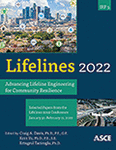A New Landslide Runout Model and Implications for Understanding Post Wildfire and Earthquake Threats to Communities in California
Publication: Lifelines 2022
ABSTRACT
Wildfires and earthquakes contribute to a nearly ever-present cycle of hazards that are man-aged by coastal California communities every year. Worse still, fires, and earthquakes drive slope instability, primarily in the form of debris flows, debris avalanches, and debris floods whose runout can impact environment, infrastructure, and threaten lives along the landslide path. A better understanding of future landslide runout paths, travel distance, and potential landslide depth along the path, will improve our ability to manage future hazards; however, predictive models can be difficult to implement, hard to calibrate, and/or expensive to acquire. DebrisFlow Predictor is an agent-based runout model that predicts runout, inundation, scour, and deposition along the path, of debris flows and debris avalanches. Results credible and easily verified (numerically or visually) using several built-in features. DebrisFlow Predictor is intended to better inform and constrain land management decisions where debris flow and debris avalanche hazards exist.
Get full access to this article
View all available purchase options and get full access to this chapter.
REFERENCES
Benda, L. E., and Cundy, T. W. (1990). “Predicting deposition of debris flows in mountain channels”. Canadian Geotechnical Journal, 27,409–417.
Bruhn, R., Harris, C. B., and Lund, W. (2005). Neotectonics and paleoseismology of the Wasatch fault, Utah.
Cannon, S. H., Gartner, J. E., Wilson, R. C., Bowers, J. C., and Laber, J. L. (2008). “Storm rainfall conditions for floods and debris flows from recently burned areas in southwestern Colorado and southern California”. Geomorphology, 96,250–269.
Chiang, S. H., Chang, K. T., Mondini, A., Tsai, B. W., and Chen, C. Y. (2012). “Simulation of event-based landslides”. Geomorphology, pages 306–318.
Ciurean, R. L., Hussin, H., vanWesten, C. J., Jaboyedoff, M., Nicolet, P., Chen, L., Frigerio, S., and Glade, T. (2017). “Multi-scale debris flow vulnerability assessment and direct loss estimation of buildings in the Eastern Italian Alps”. Natural Hazards, pages 929–957.
Corominas, J. (1996). “The angle of reach as a mobility index for small landslides”. Canadian Geotechnical Journal, 33,260–271.
Crescenzo, L., Pecoraro, G., Calvello, M., and Guthrie, R. (2021). A probabilistic model for assessing debris flow propagation at regional scale: a case study in Campania region, Italy. EGU21-2224, European Geophysical Union General Assembly, 2021.
Crittenden, M. D., and Sorensen, M. L. (1985). Geologic map of the North Ogden quandrangle and part of the Odgen and Plain City quadrangles, Box Elder and Weber Counties, Utah.
DuRoss, C., Crone, S., McDonald, G., and Briggs, R. (2012). Plate Holocene earthquake history of the Brigham City Segment of the Wasatch Fault Zone at the Hansen Canyon, Kotter Canyon, and Pearsons Canyon trench sites, Box Elder County, Utah.
Gartner, J. E., Cannon, S. H., and Santi, P. M. (2014). “Empirical models for predicting volumes of sediment deposited by debris flows and sediment-laden floods in the transverse ranges of southern California”. Engineering Geology, 176,45–56.
Guthrie, R. H., and Befus, A. (2020). “DebrisFlow Predictor: an agent-based run-out program for shallow landslides”. Natural Hazards and Earth System Sciences. In review at time of writing.
Guthrie, R. H., Deadman, P., Cabrera, R., and Evans, S. G. (2008). “Exploring the magnitude- frequency distribution: a cellular automata model for landslides”. Landslides, 5,151–159.
Guthrie, R. H., Hockin, A., Colquhoun, L., Nagy, T., and Evans, S. G. (2010). “An examination of controls on debris flow mobility: Evidence from coastal British Columbia”. Geomorphol- ogy, 114,601–613.
Harp, E. L., and Jibson, R. W. (1995). Inventory of landslides triggered by the 1994 Northridge, California earthquake.
Horton, P., Jaboyedoff, M., and Zimmermann, M. (2013). “Flow-R, a model for susceptibility mapping of debris flows and other gravitational hazards at a regional scale”. Natural Hazards and Earth System Sciences, 13,869–885.
Hungr, O. (1995). “A model for the runout analysis of rapid flow slides, debris flows and avalanches”. Canadian Geotechnical Journal, 32,610–623.
Iverson, R. M. (1997). “The physics of debris flows”. Review of Geophysics, 35,245–296.
Kean, J. W., Staley, D. M., Lancaster, J. T., Rengers, F. K., Swanson, B. J., Coe, J. A., Her- nandez, J. L., Sigman, A. J., Allstadt, K. E., and Lindsay, D. N. (2019). “Inundation, flow dynamics, and damage in the 9 January 2018 Montecito debris-flow event, California, USA: Opportunities and challenges for post-wildfire risk assessment”. Geosphere, 15,1140–1163.
Mayes, B. H. (1992). Technical Reports for 1990-1991 Applied Geology Program.
Morton, D. M., Alvarez, R. M., Campbell, R. H., and California Geological Survey. (2003). “Preliminary soil-slip susceptibility maps, southwestern California”., pages 1–46.
O’Brien, J. S., Julien, P. Y., and Fullerton, W. T. (1993). Two-dimensional water flood and mudflow simulation, 119,244–261.
Rickenmann, D. (1990). “Debris flows 1987 in Switzerland: modelling and sedi- ment trans- port”. International Association of Hydrological Sciences, 194,371–378.
Santi, P., Cannon, S., and DeGraff, J. (2013). “Wildfire and landscape change.” In Shroder, J., James, L. A., Harden, C. P., and Clague, J. J., editors, Treatise on Geomorphology, Geo- morphology of Human Disturbances, Climate Change, and Natural Hazards, pages 262–287, San Diego CA. Academic Press.
State of California, D. o. F. (2020). E-2. California County Population Estimates and Compo- nents of Change by Year, July 1, 2010-2020.
USGS. (2020). Bobcat Fire (Angeles National Forest, CA).
USGS and California Geological Survey. (2005). Southern California Landslides-An Overview.
Wise, M. P. (1997). Probabilistic modelling of debris flow travel distance using empirical volumetric relationships.
Information & Authors
Information
Published In
History
Published online: Nov 16, 2022
Authors
Metrics & Citations
Metrics
Citations
Download citation
If you have the appropriate software installed, you can download article citation data to the citation manager of your choice. Simply select your manager software from the list below and click Download.
